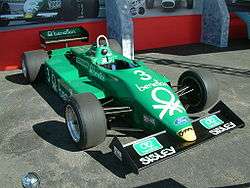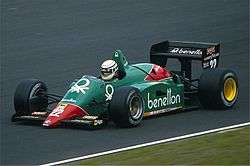Benetton Group
 | |
| Società a responsabilità limitata | |
| Industry | Fashion |
| Founded | 1965 in Ponzano Veneto, Italy |
| Founder | Luciano Benetton |
| Headquarters | Ponzano Veneto, Italy |
Area served | Worldwide |
Key people |
|
| Products | |
| Revenue | 1.529 billion Euro (2015) |
Number of employees | 7,714 (2015) |
| Website |
www |
Benetton Group S.r.l. (Italian pronunciation: [benetˈton][1]) is a global fashion brand based in Ponzano Veneto, Italy. The name comes from the Benetton family, who founded the company in 1965. Benetton has a network of about 5,000 stores in the main international markets.[2]
Early years

In 1963, Luciano Benetton, the oldest of four children, was a 30-year-old salesman in Treviso. His initial small collection of sweaters received a positive response in local stores in the Veneto region, and soon after he asked his sister and two younger brothers, Gilberto and Carlo, to join him. In 1965, the entity known as the "Benetton Group" was formed.[3]
In 1965, the Benettons opened their first store in Belluno[4] and three years after in Paris, with Luciano as chairman, his brother Gilberto in charge of administration, their younger brother Carlo running production, and Giuliana as a chief designer.
Brands
The company's core business remains their clothing lines: United Colors of Benetton,[5] and Sisley.[6]
The Group has a network of about 5,000 stores around the world.[2]
Marketing
The company is known for sponsorship of a number of sports, and for the provocative and original "United Colors" publicity campaign. The latter originated when photographer Oliviero Toscani was given carte blanche by the Benetton management. Under Toscani's direction, ads were created that contained striking images unrelated to any actual products being sold by the company.
Up to 1982, Benetton marketing campaigns relied on traditional models wearing the brand clothing. In 1982, the company decided to change its advertising campaigns by focusing on world issues to raise awareness and create an added value for the brand. In 1984, Oliviero Toscani photographed the first multiracial ad for the brand.[4]
These graphic, billboard-sized ads included depictions of a variety of shocking subjects, one of which featured a deathbed scene of a man (AIDS activist David Kirby) dying from AIDS.[7] Others included a bloodied, unwashed newborn baby with umbilical cord still attached, which was highly controversial. This 1991 advert prompted more than 800 complaints to the British Advertising Standards Authority during 1991 and was featured in the reference book Guinness World Records 2000 as 'Most Controversial Campaign'. Others included a black stallion covering a white mare,[8] close-up pictures of tattoos reading "HIV Positive" on the bodies of men and women, a cemetery of many cross-like tombstones, a collage consisting of genitals of persons of various races, a priest and nun about to engage in a romantic kiss, pictures of inmates on death row, an electric chair, an advert showing a dark-skinned boy with hair shaped into the devil's horns, three different hearts with "black", "white" and "yellow" written onto them (from March 1996), and a picture of a bloodied T-shirt and pants riddled with bullet holes from a soldier killed in the Bosnian War (appeared in February 1994).[9] Most of the advertisements, although not all, had a plain white background, and in most the company's logo served as the only text accompanying the image.
2011 marketing campaign
In autumn 2011, Benetton launched its new worldwide communication campaign, an invitation to the leaders and citizens of the world to combat the "culture of hatred", and created the UNHATE Foundation.[10] This campaign was created as the group’s corporate social responsibility strategy and not as a cosmetic exercise.[11] The Benetton Group “seeks to contribute to the creation of a new culture against hate”.[11] Benetton’s Fabrica research centre partnered up with 72andSunny to create the UNHATE poster series.[12] According to Benetton “These are symbolic images of reconciliation—with a touch of ironic hope and constructive provocation—to stimulate reflection on how politics, faith and ideas, even when they are divergent and mutually opposed, must still lead to dialogue and mediation”.[13] 72andSunny adds “United Colors of Benetton returns to the cultural conversation with a simple and powerful message of tolerance: UNHATE. Hate and love are often in a delicate and unstable balance. This campaign promotes a shift in the balance”.[14] However, these posters of the lip-locking political and religious figures have sparked controversy. In addition, Benetton released an advertisement that displayed President Barack Obama of the United States and President Hugo Chávez of Venezuela kissing.[15]
On 17 November 2011, The Vatican announced that it would take legal action against Benetton after the company used a photo purportedly showing Pope Benedict XVI kissing Ahmed Mohamed el Tayeb, the imam of the Al Azhar mosque in Egypt. Benetton responded: "We reiterate that the meaning of this campaign is exclusively to combat the culture of hatred in all its forms," said a Benetton Group spokesman. "We are therefore sorry that the use of the image of the Pope and the Imam has so offended the sentiments of the faithful. In corroboration of our intentions, we have decided, with immediate effect, to withdraw this image from every publication."[16]
In November 2017, UCB launched a campaign in collaboration with Devbhumi, a registered company owned by rural women from remote villages in Uttarakhand state of India. The initiative claims to empower over 6,000 rural women artisans across India. [17]
Sport and sponsorship
Benetton Group entered Formula One as a sponsor of Tyrrell in 1983, then Alfa Romeo in 1984; this arrangement was extended to both Alfa and Toleman in 1985. Benetton Formula Ltd. was formed at the end of 1985 when the Toleman and Spirit teams were sold to the Benetton family. The team saw its greatest success under Flavio Briatore, who managed the team from 1990 to 1997. Michael Schumacher won his first Drivers' Championships with the team in 1994 and 1995, and the team won their only Constructors' title in 1995. From 1996, the team raced under an Italian licence although it continued to be based, like Toleman, in Oxfordshire in England. The team was bought by Renault for US$120 million in 2000 and was rebranded Renault F1 in 2002.
In 1979, Benetton first sponsored their (then amateur) local rugby team, A.S. Rugby Treviso. Benetton Rugby has since become a major force in Italian rugby, with 11 league titles and supplying many players to the national team.[18] Benetton Group has also sponsored Treviso Basket (1982–2012) and Sisley Volley (1987–2012).
 The 1983 season Tyrrell 011, showing the company's logo at the time.
The 1983 season Tyrrell 011, showing the company's logo at the time.- Schumacher's B194 of the 1994 season.
 Riccardo Patrese's Alfa Romeo Benetton 185T.
Riccardo Patrese's Alfa Romeo Benetton 185T.
Criticisms
Benetton has faced criticism from Mapuche organizations over its purchase of traditional Mapuche lands in Patagonia.[19] The Curiñanco-Nahuelquir family was evicted from their land in 2002 following Benetton's claim to it, but the land was restored in 2007.[20] The company have published a position statement regarding the Mapuche in Patagonia.[21]
Benetton aroused suspicion when they considered using RFID tracking chips on clothes to monitor inventory. A boycott site alleges the tracking chips "can be read from a distance and used to monitor the people wearing them."[22] Issues of consumer privacy were raised and the plan was shelved. Benetton's position on RFID technology is also available on their website.[23]
PETA launched a boycott campaign against Benetton for buying wool from farmers who practiced mulesing. Benetton has since agreed to buy nonmulesed wool and has further urged the wool industry to adopt the PETA and Australian Wool Growers Association agreement to end mulesing.[24] Benetton's position statement on the mulesing controversy is available on their website.[25]
Building collapse at Savar
On 24 April 2013, the eight-storey Rana Plaza commercial building collapsed outside Dhaka that housed one of the factories where Benetton makes its clothing.[26] At least 1,130 people died.[27] Benetton first denied reports linking production of their clothing at the factory, but clothes and documents linked to Benetton were discovered at the disaster site.[28][29][30] Of the 29 brands identified as having sourced products from the Rana Plaza factories, only nine attended meetings held in November 2013 to agree a proposal on compensation to the victims. Several companies refused to sign including Walmart, Carrefour, Bonmarché, Mango, Auchan and Kik. The agreement was signed by Primark, Loblaw, Bonmarche and El Corte Ingles.[31] A year after the collapse, Benetton faced international protests after failing to pay any compensation to the Rana Plaza Donors Trust Fund.[32][33] Protests included shutting down Benetton's flagship Oxford Street store in London.[34]
On April 2015, Benetton Group announced that it has doubled compensation for Rana Plaza victims recommended by independent assessors (PWC AND WRAP) and applied the principles of the Accord on Fire and Building Safety to global suppliers. Benetton’s engagement for Bangladesh is available on their website.[35]
See also
Notes and references
- ↑ "DOP". Dizionario.rai.it. Retrieved 28 June 2012.
- 1 2 "At a glance". Benetton Group. Retrieved 5 May 2010.
- ↑ Timeline of the Benetton Group Benetton Group Official Webpage
- 1 2 Brady, Donald L. (2014-12-18). Essentials of International Marketing. Routledge. ISBN 9781317471202.
- ↑ "United Colors of Benetton". Retrieved 10 June 2015.
- ↑ "Sisley". Sisley. 2012-02-21. Retrieved 2012-06-28.
- ↑ "The Photo That Brought AIDS Home". Retrieved 2010-07-22.
- ↑ "El caso de Benetton". PERIODISMO DE MARCA. Retrieved 10 June 2015.
- ↑ "Benetton-Bosnian Soldier Home". Retrieved 2010-07-22.
- ↑ "UNHATE Foundation". UNHATE Foundation. Retrieved 2012-06-28.
- 1 2 "The Foundation | Unhate Foundation". Unhate.benetton.com. 2012-06-20. Retrieved 2012-06-28.
- ↑ "2011". Creative Review. Retrieved 2012-06-28.
- ↑ Mail Foreign Service (2011-11-17). "Benetton 'Unhate' advert of Pope kissing imam withdrawn after Vatican calls it 'disrespectful' | Mail Online". London: Dailymail.co.uk. Retrieved 2012-06-28.
- ↑ "72andSunny". 72andSunny. 2011-04-07. Retrieved 2012-06-28.
- ↑ https://www.cnbc.com/id/45326469
- ↑ "Benetton Press Note". Benettongroup.com. Retrieved 2012-06-28.
- ↑ "Fashion brand aims to empower over 6,000 women weavers".
- ↑ "Benetton Rugby - Storia" (in Italian). Archived from the original on 2008-04-14. Retrieved 2008-04-07.
- ↑ "The Invisible Colours of Benetton - Campaign". Retrieved 2008-04-07.
- ↑ "Recovered Mapuche territory in Patagonia: Benetton vs. Mapuche". MAPU Association. Archived from the original on 2012-09-08. Retrieved 2008-04-07.
- ↑ "Benetton's position regarding the Mapuche in Patagonia". Archived from the original on 25 June 2012.
- ↑ "Boycott Benetton". Retrieved 2008-04-07.
- ↑ "Benetton's position on RFID technology".
- ↑ "Campaign ends". PETA Save the Sheep! campaign. Retrieved 2008-04-07.
- ↑ "Benetton's position regarding the controversy on mulesing between the Australian Wool Industry and PETA".
- ↑ Ahmed, Saeed; Lakhani, Leone (14 June 2013), "Bangladesh building collapse: An end to recovery efforts, a promise of a new start", CNN, retrieved 16 December 2013
- ↑ "Rana Plaza factory collapse survivors struggle one year on". BBC News. 23 April 2014. Retrieved 12 March 2015.
- ↑ "Benetton denies to have any involvement with Bangladesh factory in their Tweet".
- ↑ Cohn, Emily (2013-04-29). "Benetton Denies Ties To Deadly Bangladesh Factory, But Its Shirts Were Found In The Rubble: Quartz (PHOTOS)". Huffington Post.
- ↑ "Bangladesh factory collapse death toll rises above 1,000".
- ↑ Ovi, Ibrahim Hossain (2013), Buyers' compensation for Rana Plaza victims far from reality, archived from the original on 25 March 2016, retrieved 16 December 2013
- ↑ Tichborne, Beth (2014-04-26). "Benetton stores targeted by global protests". Indymedia UK.
- ↑ Butler, Sarah (2014-04-24). "Rana Plaza disaster marked by Oxford Street demonstration". The Guardian.
- ↑ Kilcooley-O'Halloran, Scarlett (2014-04-25). "Benetton Rana Plaza Protests". Vogue.
- ↑ "Benetton Group - Corporate Website".
External links

